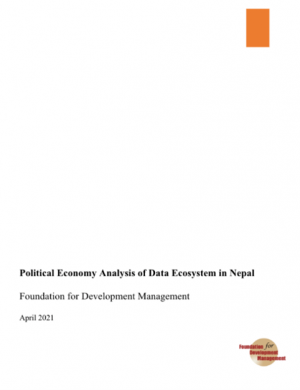
Keeping Girls in STEAM to Become Women in Data
April 2, 2021Census Observation
November 25, 2021Evidence based decision making in Nepal: Making strides. But still a long way to go.
The 2017 local elections held in Nepal were particularly notable for two reasons. First, the local elections were being held for the first time in two decades. In a momentous event, the elections thus saw elected representatives take office in the 753 local levels for the first time since 1997. Secondly, it was the first election held after the promulgation of the 2015 constitution which had given the local levels an unprecedented level of power and authority. The election was a landmark moment in the country’s transition to federalism. As the elected local representatives prepare to leave office with only one year of their tenure remaining, many are looking back to assess their performance. While local units definitely increased people’s access to services and minimized the gap between people and their governments, they were also plagued with many problems. Some of the most common ones were lack of human and financial resources and poor accountability and transparency practices.
One such issue concerning the local governments was the lack of local level data. As the new federal structure of Nepal delegated important functions to the provincial and local governments, such as policymaking, planning and data production, it was critical that these local units had accurate local data and strong information ecosystems. However, the practice of using data and statistics in Nepal has been largely absent with ad-hoc decision making being largely prevalent. Evidence-based decision making has not been practiced among many local governments.
In this context, Foundation for Development Management, a research and Monitoring and Evaluation (M&E) consulting firm based in Kathmandu Nepal undertook a political economic analysis to understand the use of data and evidence in decision making in three of the local units – Tulsipur sub-metropolitan city in Lumbini Province, Birgunj municipality in Province 2 and Simta rural municipality in Karnali province. Following consultations with stakeholders ranging from Ministers, Secretaries, officials from National Planning Commission (NPC), Provincial Planning Commission (PPC), Central Bureau of Statistics (CBS) and chief of local units among others, FDM found that the practice of evidence-based decision making was largely contingent on the nature of leadership. In the case of provinces, Lumbini province was found to be attaching the highest importance to evidence-based decision making whereas in the case of local units, it was Simta and Tulsipur.
A common factor across all these three areas was their respective chiefs’ proactive stance on the use of data. Steps such as setting up of Information Technology Academy to generate data exemplified the commitment of Province 5 to evidence-based decision making whereas in Simta, the collection of primary data with the objective of long-term goal setting and in Tulsipur, administration of survey with a sample as large as 28,000 to improve the education sector (and planning of similar surveys in the future) reflected the priority attached to using data and evidence in making decisions.
On the other hand, the practice of using data and evidences in Birgunj and Province 2 was relatively poor, thanks to the influence of senior leaders whose priorities were far from data and evidence. The level of priority placed on data and evidence was low also in Karnali province where the Chief Minister (CM) – the most influential actor in the province – was involved in political maneuvering and saving his position. Bureaucrats were also found to be another influential actor with the study uncovering that their friction with the provincial leaders as well as their ‘reluctance’ in signing off projects often acted both ways – at times acting as a check and balance but also at times, causing delay in much needed projects. Furthermore, one of the stumbling blocks for Karnali, Province 2 as well as Birgunj was also the actors who felt that they ‘knew their area well and did not require data to make decisions’.
One of the cross-cutting issues prevalent across the provincial as well local level was undue political influence. Decisions were made at the behest of senior leaders or based on party interest, personal favoritism and short-term gains. This was seen mostly in Province 2 and Karnali province but was also observed in Lumbini province, Simta and Tulispur. Province 2 and Birgunj often saw leaders making ‘populist’ decisions to appease voters while in Karnali, appeasement of rebelling factions and cadres was prioritized over evidence-based decision making. Despite efforts to foster evidence-based decision making, local units sometimes had to cave in to political pressure in matters like allotting resources (to the ward level), as was the case seen in Simta and Tulispur.
A result of provinces and local units not placing high importance on evidence and data driven decision making was that it had resulted in a vacuum for data. While the efforts of Simta and Tulsipur in promoting data driven decision making was commendable, even they stumbled upon the problem of lack of reliable data. In Province 2 and in Birgunj, there was neither adequate data for informed decision making nor was there an effort from the local government to promote it. An example of this was seen in the Beti Padhau Beti Bachau project in which the project was implemented not on the basis of any data but as a direct copy of the project with the same name in Bihar.
The problem was not just with the supply side but also the demand side. One of the main findings of the study was that there was limited awareness – amongst both public and private actors – regarding how data and evidence contributed to effective decision-making. Civil society members stated that people were hardly concerned about data or evidences; their concerns were almost always lopsided and self-centered. Even in Simta and Tulispur where the respective local chiefs were making efforts to promote evidence-based decision making, the demand side of data was very limited. The rural municipality chief of Simta accepted that many at times during social audits or public hearings, he saw the same faces. In Birgunj and Tulsipur, FDM came across a number of community members who felt that data and evidences were least of their concern.
In recent years bolstering data production has been the primary focus of development partner interventions in Nepal. Along with development partners, the Government of Nepal (GoN) too has been undertaking initiatives to promote data driven and evidence based decision making in Nepal by introducing various management systems like the Education Management Information System (EMIS), Health Management Information System (HMIS) and Sub-National Treasury Regulatory Application (SuTRA). While these steps have helped to some extent, FDM’s study showed that in places like Province 2 and Birgunj, a lot still remains to be done.
The role of The Asia Foundation’s programs such as the Data for Development (D4D) becomes particularly important in this context. The D4D Program aims to improve the sharing and use of data as evidence for decision-making and better development in Nepal. It builds on Development Initiatives’ efforts since 2011 to improve the sharing and use of data for sustainable development of Nepal by catalyzing a functional, inclusive and locally led data ecosystem as well as The Asia Foundation’s work in Nepal and across Asia to promote the use of data as evidence for development by policy makers, civil society and the private sector.




